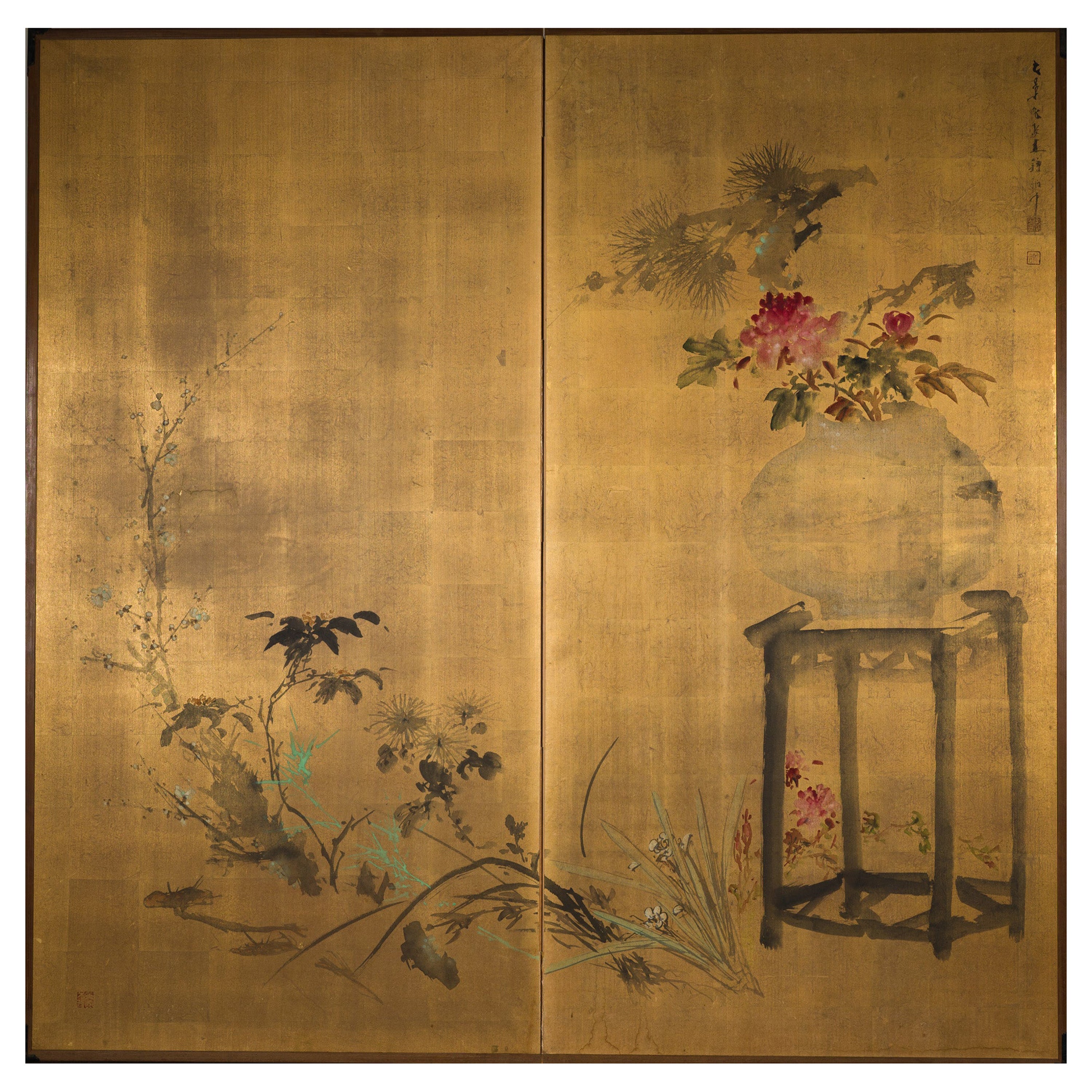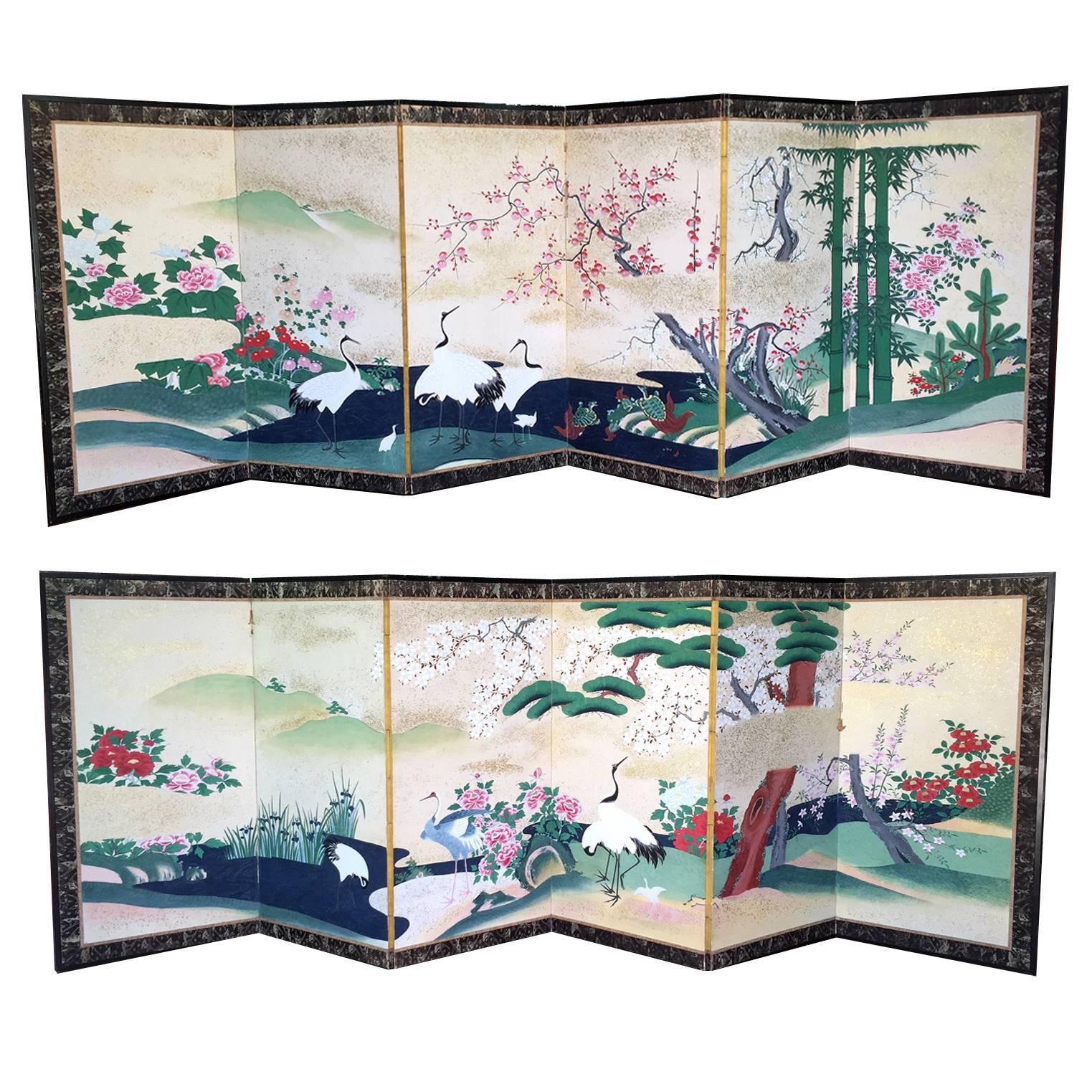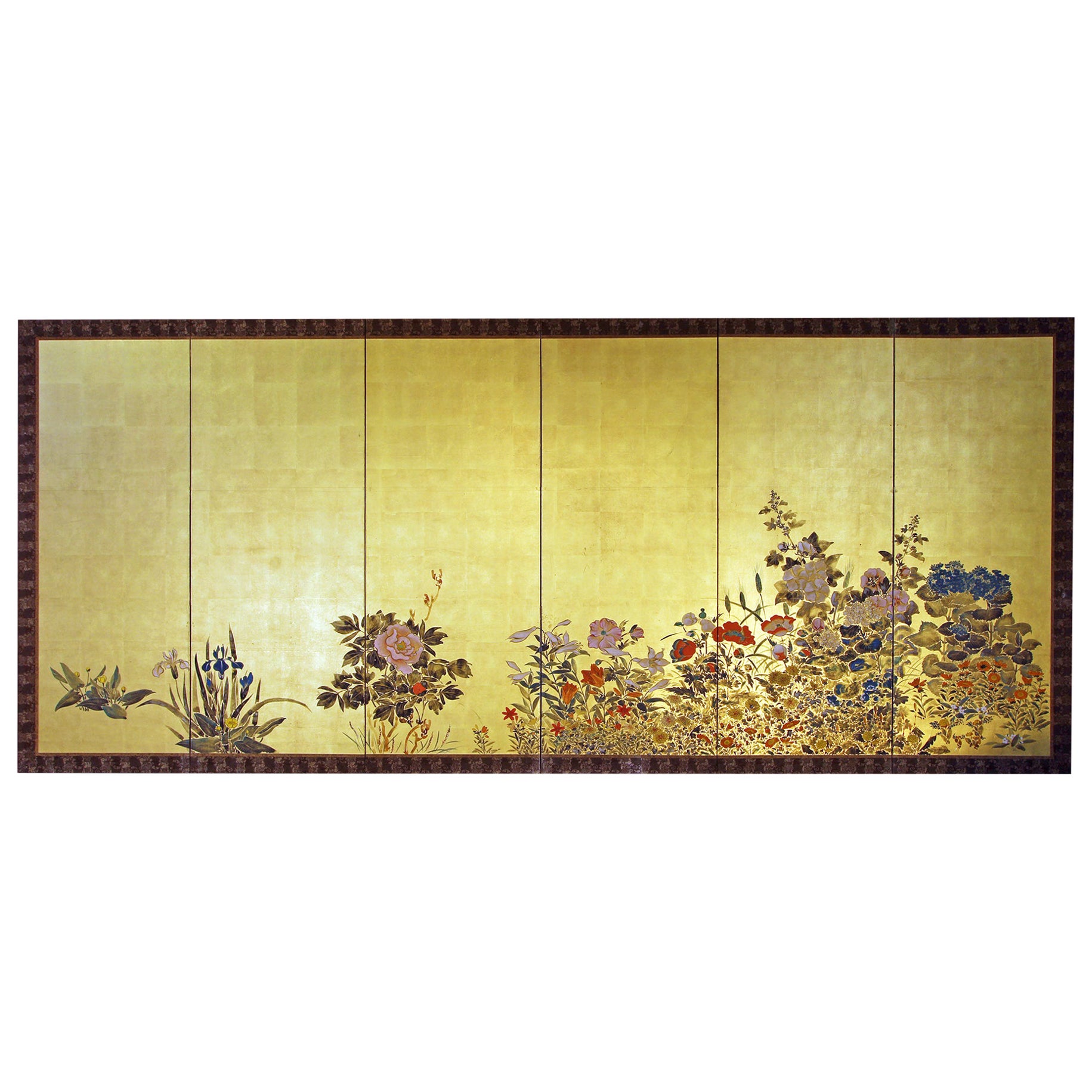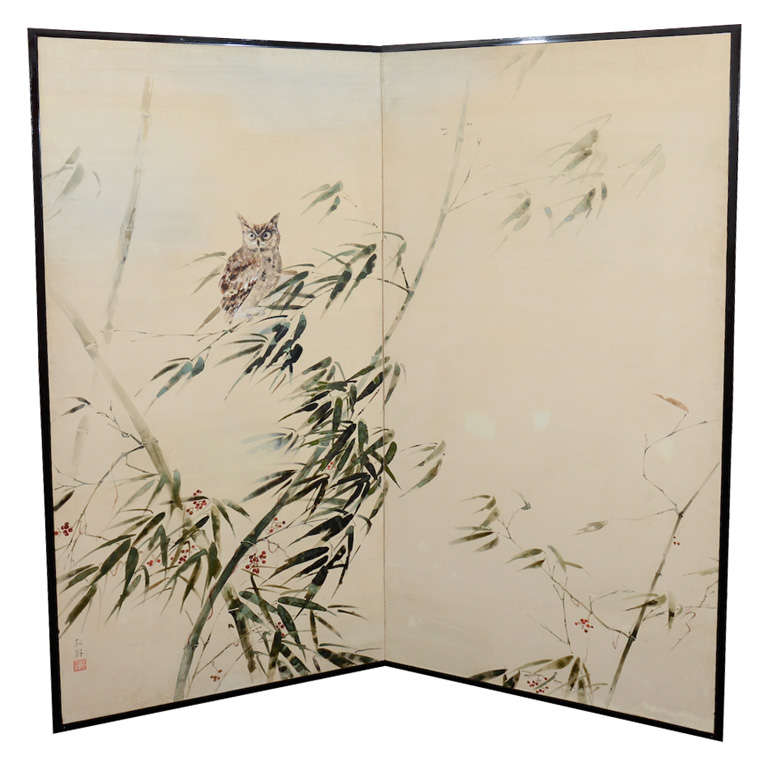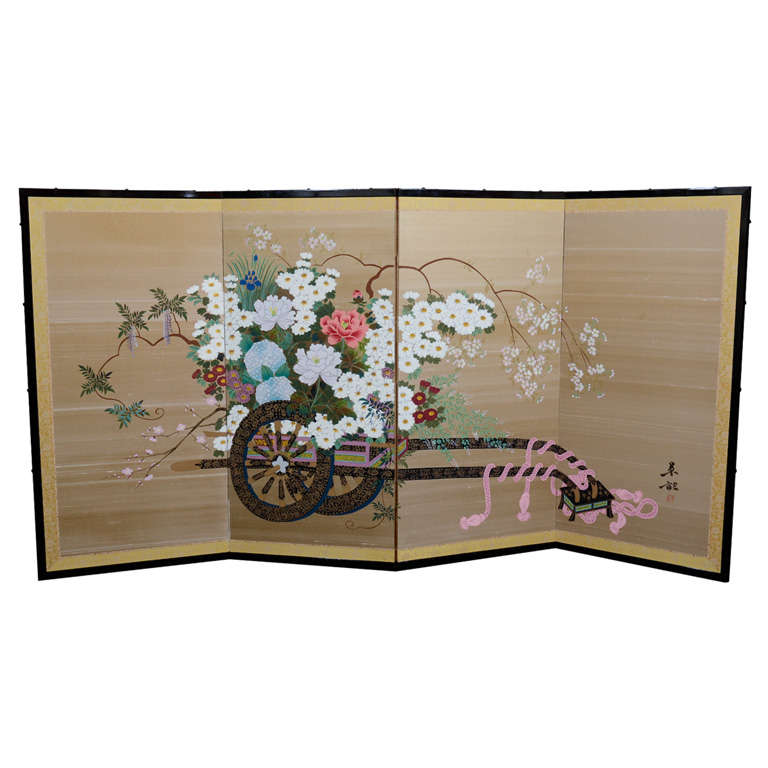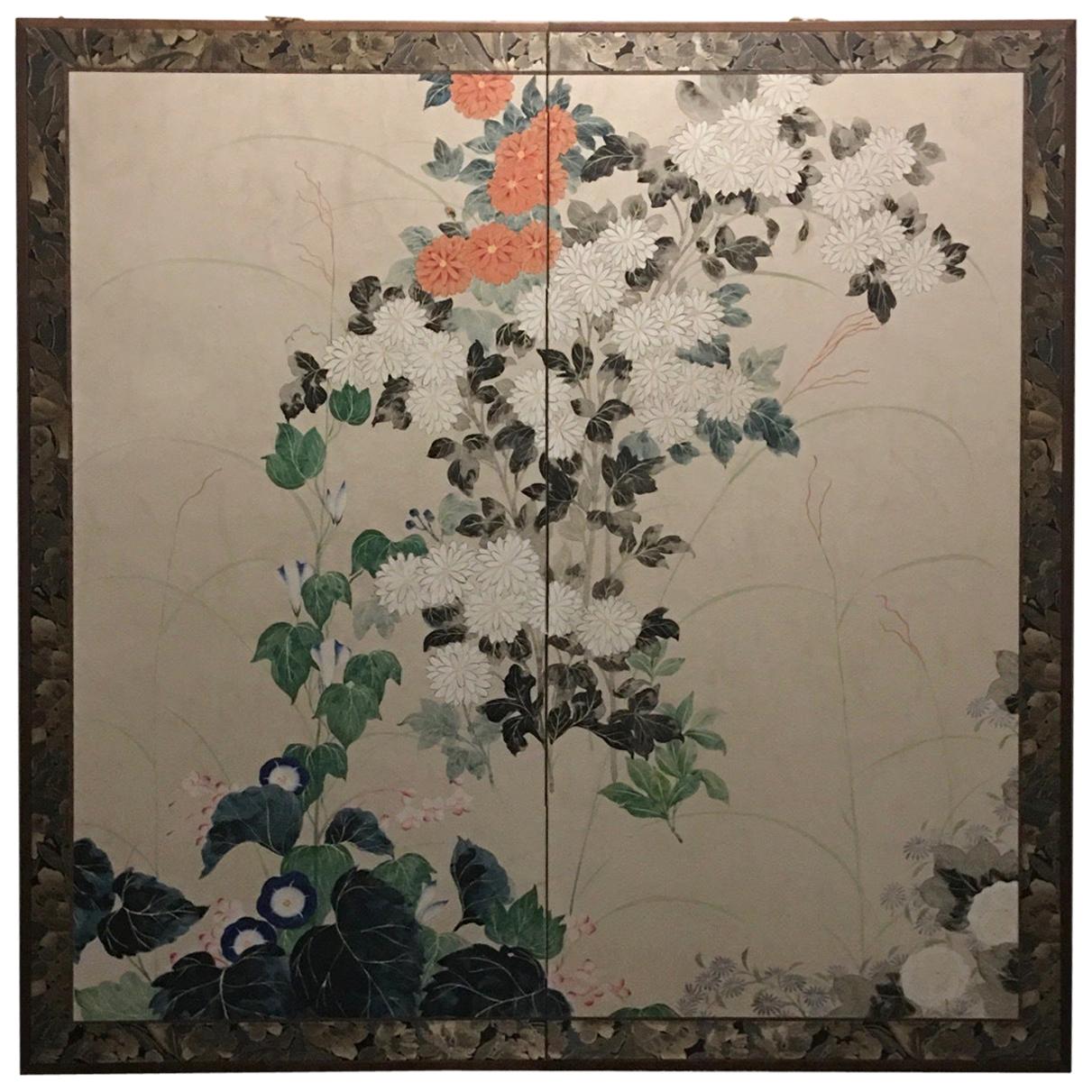Items Similar to Pair of Japanese Two-Fold Screens with Flower Arrangements and Rare Birds
Want more images or videos?
Request additional images or videos from the seller
1 of 12
Pair of Japanese Two-Fold Screens with Flower Arrangements and Rare Birds
About the Item
Karamono with flower arrangements and rare birds
Edo period, 18th century
Pair of two-panel folding screens Ink, colors, gofun and gold leaf on paper
Each 170 by 165 cm
The term karamono is used to define ceramic, carvel lacquerware, furniture, bronzes and other decorative items imported from China. They became highly prized as imported curios, used in Japan as kazari - display items - and even the shogun would install karamono in his chamber (zashiki) and invite members of the court and clergy to view them. Often karamono have been copied by Japanese craftsmen, so shapes from Chinese bronzes and porcelain have been used in Japan for centuries. Flower baskets for ikebana were also imported from China. These karamono baskets had formal, symmetrical structures with tightly plaited weaves. Unlike those used during the tea ceremony, that maintain a natural and austere wabi-sabi construction, karamono bamboo baskets, like those represented on this pair of screens, were modelled on Chinese bronzes and show classical forms. Chinese bronzes themselves, as seen here, would also be used to display flower compositions. Even exotic birds would serve as kazari. While bird-keeping was already popular since the early Edo period for the enjoyment of their songs, the habit of breeding birds for aesthetic purposes was quite unusual. Some entertainment stalls kept parrots and other rare specimens in exquisite cages for their customers’ enjoyment. The composition of this pair of screens seems inspired by the same amusement: kept on an elaborate perch or in an elegant cage fitted with a scholar’s stone, these birds are intended to intrigue and fascinate the viewer. Also, natural history studies became fashionable in Japan during the 18th century, due to the import of European books and prints. These imported images inspired paintings of rare birds which, regardless of whether they had any significance or meaning, were highly appreciated by collectors. Painting with this style were introduced by the nanga samurai painter and Confucian scholar Yanagisawa Kien (1703 - 1758), who began his training with artists of the Kano school, but became a disciple of Watanabe Shuseki and then of the nanga painter Gion Nankai.
- Dimensions:Height: 66.93 in (170 cm)Width: 64.97 in (165 cm)Depth: 0.4 in (1 cm)
- Materials and Techniques:
- Place of Origin:
- Period:
- Date of Manufacture:circa 1750
- Condition:Wear consistent with age and use.
- Seller Location:Milano, IT
- Reference Number:1stDibs: LU4250218827012
About the Seller
5.0
Recognized Seller
These prestigious sellers are industry leaders and represent the highest echelon for item quality and design.
Established in 2005
1stDibs seller since 2018
10 sales on 1stDibs
Typical response time: 2 hours
- ShippingRetrieving quote...Ships From: Milano, Italy
- Return PolicyA return for this item may be initiated within 7 days of delivery.
More From This SellerView All
- Pair of Six-Panel Folding Screens with Peonies and Other FlowersLocated in Milano, ITA pair of six-panel folding screens with peonies and other flowers 19th century Each 72.5 by 241 cm Small and elegant screens with an ideal scene depicting peonies and other flower species...Category
Antique 19th Century Japanese Paintings and Screens
MaterialsPaper
- Pair of Japanese Screens with Flowers of the Four Seasons, 19th CenturyLocated in Milano, ITThis pair of screens belongs to a genre of lyrical paintings of flowers, grasses, and other plants that flourished around the middle of the 17th century and became a specialty of the Sôtatsu studio. The use of a rather complex composition of clusters of flowers and the puddling of ink was initiated by Tawaraya Sôtatsu, the founder of the Rimpa School, who was active from 1600 until 1642. The screens are abstract and decorative but there is, at the same time, a keen sense of naturalism not only in the attention to accurate detail but in the profusion of vegetation. The passage of the year is symbolized by the variety of plants that bloom in different seasons. The tarashikomi - here used on leaves, petals and trunks - is a Classic Rinpa technique in which pale black ink or a color is brushed onto an area of a painting and then either darker ink, or the same or a contrasting color, is dropped into the first before it has completely dried, creating an effect of pooled colors with softly blurred edges. Its delicacy, preciousness, and effeminacy are identified with the over-refinement of its patrons, while the vigor, monochromatic discipline, sharp observation, and virile forms of the Kano school are a testament to the vitality of the rising warrior class. The plants are almost all identifiable: in the summer-spring part, you can find wheat, buttercups, irises, begonias, hydrangeas, coral bells...Category
Antique 19th Century Japanese Paintings and Screens
MaterialsPaper
- Japanese Folding Screen with a Spring Landscape, Kano School, 19th CenturyLocated in Milano, ITThe scene is dominated by a plum tree in bloom under which a couple of paradise birds is courting. The screen is crossed by a luxuriant creek, a typical feature of the springtime.Category
Antique 19th Century Japanese Paintings and Screens
MaterialsPaper
- Japanese Two-Panel Screen with Scenes at the Pleasure Quarters, 18th CenturyLocated in Milano, ITIn the pleasure districts, the stringent codes were meant to be forgotten. In this painting, some clients are watching from outside the teahouse, while some are entering, one of them...Category
Antique 18th Century Japanese Paintings and Screens
MaterialsPaper
- Hanging Scroll by Kamisaka Sekka, JapanLocated in Milano, ITThis painting represents a man waiting under a dark tree. The composition is extremely simple but suggestive. The artist, with few elements, can, in fact, create a vivid and dynamic scene, based on the tension between the strong ink stain that renders the tree and the elegant figure of the man, dressed in an aristocratic robe. Painter and designer, Kamisaka Sekka...Category
Early 20th Century Japanese Paintings and Screens
MaterialsPaper
- Painting by Maeda Josaku (Japan, 1926 – 2007), Paysage Humain N° 14, 1960Located in Milano, ITSigned: Josaku Meda. 60. Singed on the back: "Paysage humain" N°14 / 7.1960 / Josaku MAEDA / à Paris Exhibitions: Turin (Italy), Gissi Gallery, Collettiv...Category
20th Century Japanese Paintings and Screens
MaterialsCanvas
You May Also Like
- Japanese Two Panel Screen: Ikebana 'Flower Arrangement'Located in Hudson, NYMineral pigment on gold silk. Signature reads: Nana Keicho Ho, Shinsho, Gachu ; Seal reads: Soju ; Seal on reverse reads: Koto Fusai.Category
Antique Late 19th Century Japanese Paintings and Screens
MaterialsSilk
- Pair of Rare Antique Japanese Folding Screens with ProvenanceLocated in Atlanta, GAAn amazing pair of matching antique Japanese folding screen predating 1812-1813, most likely from Kano School. Six panels each depict C...Category
Antique 1810s Japanese Japonisme Paintings and Screens
MaterialsBrass
- Landscape with Flowers, Japanese Folding ScreenLocated in Brescia, ITSix-panel screen of the "Rinpa school", painted with inks on gold leaf. Colorful and sunny variety of flowers painted with great skill by an anonymous Japanese artist, who skilfully...Category
Antique Early 19th Century Japanese Meiji Paintings and Screens
MaterialsGold Leaf
- Japanese Two Panel Folding Screen with Owl and BambooLocated in New York, NYA two panel Japanese folding screen depicting an owl and bamboo on a white background. Signed and sealed Kou-ro. 4998Category
Early 20th Century Japanese Screens and Room Dividers
- Vintage Japanese "Flower Cart" Folding ScreenLocated in New York, NYA traditional style Japanese four panel folding screen depicting a flower cart full of red and white flowers. 10198Category
20th Century Japanese Screens and Room Dividers
- Japanese Two-Panel Folding Screen with Chrysanthemums and Morning GloriesLocated in New York, NYJapanese Meiji/Taisho period two panel folding screen richly painted on Mulberry paper and depicting chrysanthemums and morning glories on a ivory background. The piece is framed by ...Category
Vintage 1910s Japanese Meiji Paintings and Screens
MaterialsWood, Paper
Recently Viewed
View AllMore Ways To Browse
Folded Paper Furniture
Flower Arrangement
Japanes Birds
Japanese Birds
Birds Japan
Japanese Inspired Furniture
Antique Paper Flowers
Screen Birds
Gold Japanese Flowers
Brown Folding Screen
Birds Pair Gold
Bronze Screens
Bird And Flower Panels
Antique Folding Screen
Antique Folding Screens
Antique Folding Screen Antiques
Folding Screen Antique
Folding Screen Antique Furniture
